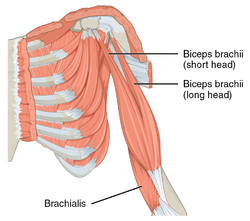| Biceps brachii | |
|---|---|
 The biceps is a two-headed muscle and is one of the chief flexors of the forearm. Here is the left side, seen from the front. | |
| Details | |
| Pronunciation | /ˈbaɪsɛps ˈbreɪkiaɪ/ |
| Origin | Short head: coracoid process of the scapula. Long head: supraglenoid tubercle |
| Insertion | Radial tuberosity and bicipital aponeurosis into deep fascia on medial part of forearm |
| Artery | Brachial artery |
| Nerve | Musculocutaneous nerve (C5–C7)[1] |
| Actions | |
| Antagonist | Triceps brachii muscle |
| Identifiers | |
| Latin | musculus biceps brachii |
| TA98 | A04.6.02.013 |
| TA2 | 2464 |
| Anatomical terms of muscle | |
The biceps or biceps brachii (Latin: musculus biceps brachii, "two-headed muscle of the arm") is a large muscle that lies on the front of the upper arm between the shoulder and the elbow. Both heads of the muscle arise on the scapula and join to form a single muscle belly which is attached to the upper forearm. While the biceps crosses both the shoulder and elbow joints, its main function is at the elbow where it flexes and supinates the forearm. Both these movements are used when opening a bottle with a corkscrew: first biceps screws in the cork (supination), then it pulls the cork out (flexion).[2]
- ^ a b c d Cite error: The named reference
Bogart2007was invoked but never defined (see the help page). - ^ Lippert LS (2006). Clinical kinesiology and anatomy (4th ed.). Philadelphia: F. A. Davis Company. pp. 126–7. ISBN 978-0-8036-1243-3.